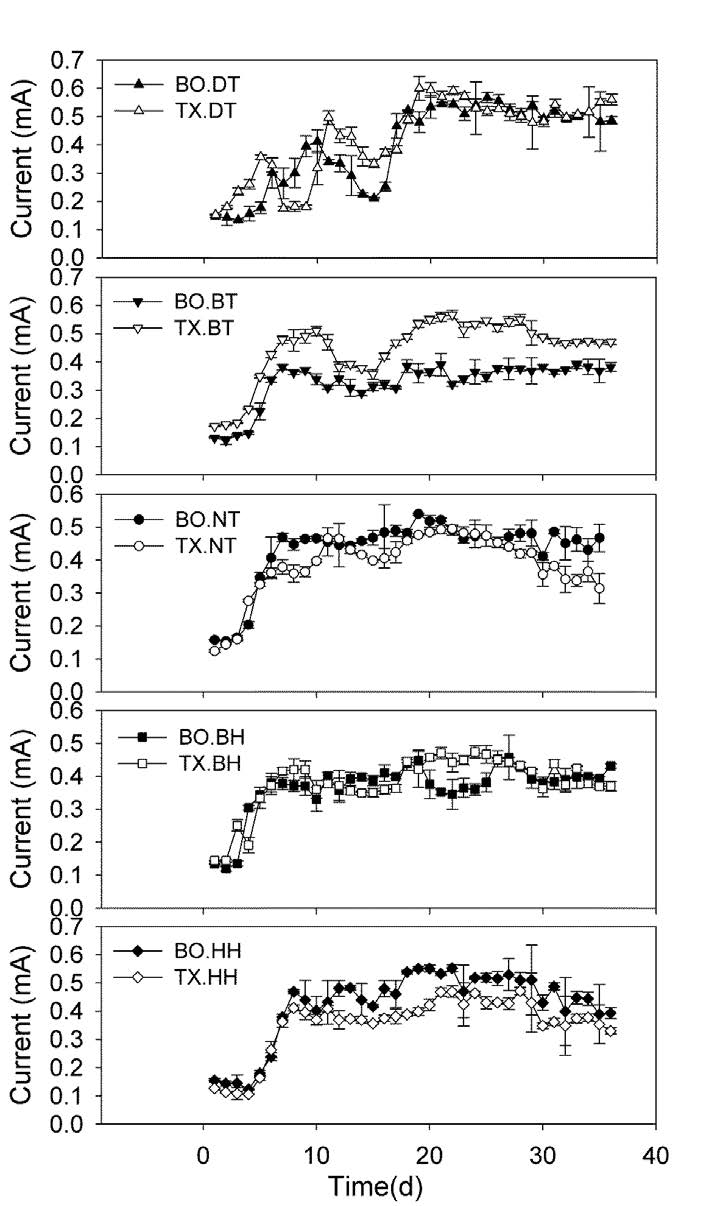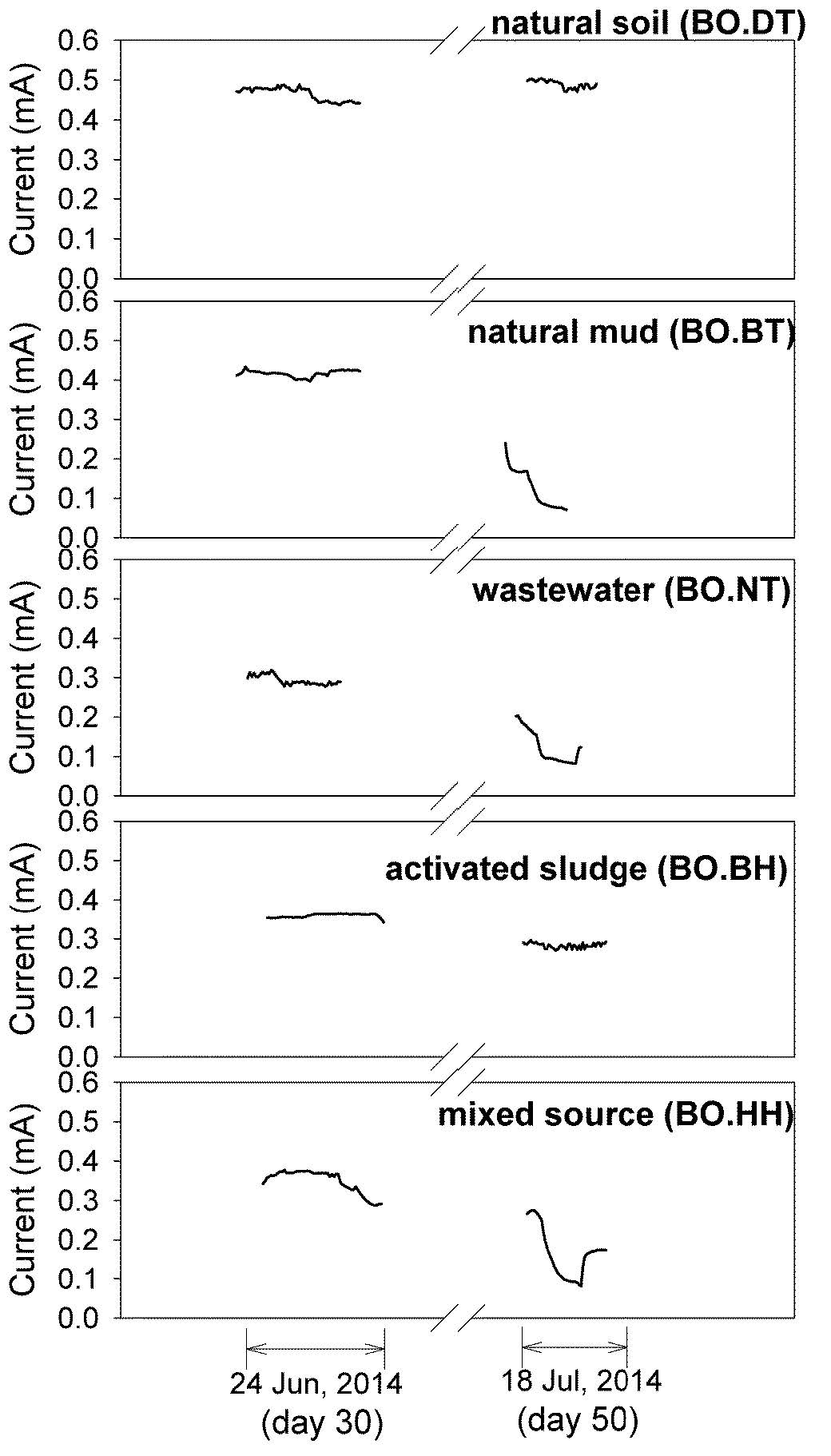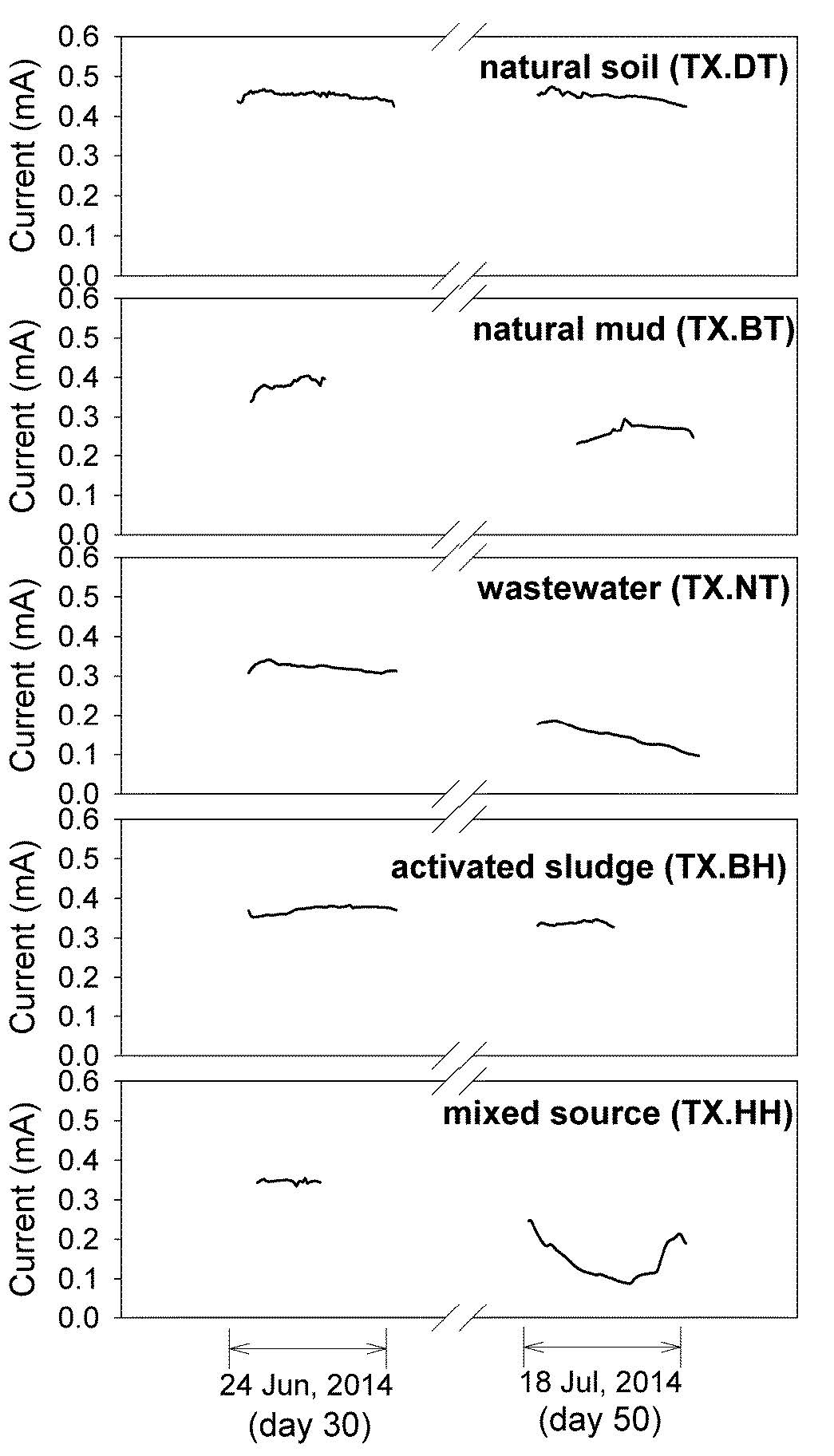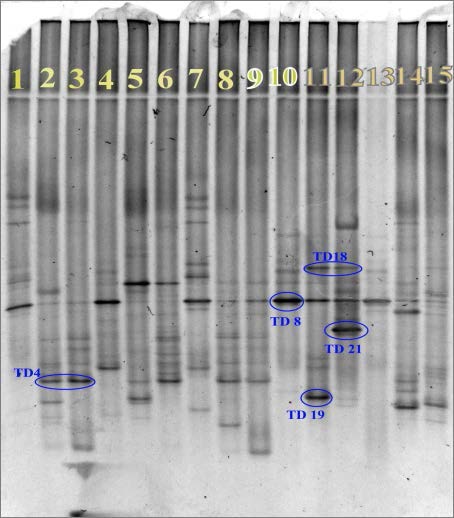Microbial fuel cells are a recently emerging technology that promises a number of applications in energy recovery, environmental treatment and monitoring. In this study, we investigated the effect of inoculating sources on the enrichment of electrochemically active bacterial consortia in sensor-typed microbial fuel cells (MFCs). Several MFCs were constructed, operated with modified artificial wastewater and inoculated with different microbial sources from natural soil, natural mud, activated sludge, wastewater and a mixture of those sources. After enrichment, the MFCs inoculated with the natural soil source generated higher and more stable currents (0.53±0.03 mA), in comparisons with the MFCs inoculated with the other sources. The results from denaturing gradient gel electrophoresis (DGGE) showed that there were significant changes in bacterial composition from the original inocula to the enriched consortia. Even more interestingly, Pseudomonas sp. was found dominant in the natural soil source and also in the corresponding enriched consortium. The interactions between Pseudomonas sp. and other species in such a community are probably the key for the effective and stable performance of the MFCs.
1.
Introduction
In mathematical analysis and its applications, the hypergeometric function plays a vital role. Various special functions which are used in different branches of science are special cases of hypergeometric functions. Numerous extensions of special functions have introduced by many authors (see [1,2,3,4]). The generalized Gamma $ k $-function and its properties are broadly discussed in [5,6,7,8]. Later on, the researchers [9] motivated by the above idea and presented the $ k $-fractional integral and its applications. The integral representation of generalized confluent hypergeometric and hypergeometric $ k $-functions is presented by Mubeen and Habibullah [10]. The series solution of $ k $-hypergeometric differential equation is proposed by Mubeen et al. [11,12,13]. Li and Dong [14] established the hypergeometric series solutions for the second-order non-homogeneous $ k $-hypergeometric differential equation. The Generalized Wright $ k $-function and its different indispensable properties are briefly discussed in [15,16]. A class of Whittaker integral transforms involving confluent hypergeometric function and Fox H-function as kernels are discussed in [17,18]. An extension of some variant of Meijer type integrals in the class of Bohemians is elaborated in [19].
Generalization of Gr$ \ddot{u} $ss-type and Hermite-Hadamard type inequalities concerning with $ k $-fractional integrals are explored in [20,21]. Many researchers have derived the generalized forms of the Riemann-Liouville $ k $-fractional integrals and established several inequalities by considering various generalized fractional integrals. The readers may confer with [22,23,24,25,26] for details.
The Hadamard $ k $-fractional integrals and Hadamard-type inequalities for $ k $-fractional Riemann-Liouville integrals are presented by Farid et al. [27,28]. In [29,30], the authors have established inequalities by employing Hadamard-type inequalities for $ k $-fractional integrals. Nisar et al. [31] discussed Gronwall type inequalities by considering Riemann-Liouville $ k $ and Hadamard $ k $-fractional derivatives. Hadamard $ k $-fractional derivative and its properties are disscussed in [32]. Rahman et al. [33] described generalized $ k $-fractional derivative operator.
The Mittag-Leffler function naturally occurs in the solutions of fractional integrodifferential equations having an arbitrary order that is similar to that of the exponential function. The Mittag-Leffler functions have acquired significant recognition due to their wide applications in assorted fields. The Mittag-Leffler stability of fractional-order nonlinear dynamic systems is studied in [34]. Dos Santos discussed the Mittag-Leffler function in the diffusion process in [35]. The noteworthy role of the Mittag-Leffler function and its generalizations in fractional modelling is explored by Rogosin [36]. We suggest the readers to study the literature [37,38,39] for more details.
Now, we present some basic definitions and results.
The normalized Wright function is defined as
Fox [40] and Wright [41] defined the Fox-Wright hypergeometric function $ _{u}\psi_{v} $ as:
where $ C_{i}\geq 0, i = 1, ..., u; D_{i}\geq 0, i = 1, ..., v. $ The function $ _{u}\psi_{v} $ is the generalized form of the well-known hypergeometric function $ _{u}F_{v} $ with u and v number of parameters in numerator and denominator respectively. It is given in [42] as:
where $ (\kappa)_n $ is called the Pochhammer symbol and is defined by Petojevic [43] as:
From definitions (1.2) and (1.3), we have the following relation
The Mittag-Leffler function with $ 2m $ parameters [44] is defined as follows:
and in the form of Fox-Wright function it can be expressed as:
The function $ \phi_{(\gamma_1, \delta_2)}^{(\delta_1, D_1)} : (0, \infty)\rightarrow \mathbb{R} $ is defined in [45] as
where $ \gamma_1, \delta_1, \delta_2 $ and $ D_1 > 0 $.
Diaz and Pariguan [46] proposed the following Pochhammer's $ k $-symbol $ (z)_{n, k} $ and the generalized Gamma $ k $-function by
respectively. They also introduced the generalized hypergeometric $ k $-function in [46] as follows:
Now, we define the normalized Wright $ k $-function as follows:
and the Fox -Wright type $ k $-function is as follows:
So from Eqs (1.9) and (1.8), we have
and (1.5) takes the form
The function $ E_{(\delta, D)_{m, k}}(z) $ in terms of the function $ _{u}\psi_{v, k} $ is expressed as
So the function (1.7) is given by
Redheffer [47] presented the following inequality in 1969,
In the same year, Redheffer and Williams [48] proved the above inequality. Zhu and Sun [49] used the hyperbolic functions $ \sinh x $ and $ \cosh x $ and proved the following Redheffer-type inequalities
and
where $ 0 < x < r, \; \gamma \leq 0, \; \delta\geq\frac{r^{2}}{12} $ and $ \delta_{1}\geq \frac{r^{2}}{4} $. By using the inequalities (1.15) and (1.16), Mehrez proved the following Theorem (see[50]).
Theorem 1.1. The following inequalities
holds true for all $ s > 0 $, $ \gamma, \delta > 0 $, $ 0 < z < s $, where $ \sigma_{\gamma, \delta} = 0 $ and $ \rho_{\gamma, \delta} = \frac{s\Gamma(\delta)}{2\Gamma(\delta+\gamma)} $ are the best possible constants and $ W_{\gamma, \delta} $ is the normalized Wright function defined by (1.1).
Recently, the same author has proved the following inequality (see[45]).
Theorem 1.2. Suppose that $ r, \gamma_1, \delta_1, \delta_2, D_1 > 0 $. Then the subsequent inequalities
are true for all $ z \in (0, r) $, where $ \lambda ^{(\delta_1, D_1)}_{\gamma_1, \delta_2} = 0 $ and $ \mu ^{(\delta_1, D_1)}_{\gamma_1, \delta_2} = \frac{r \gamma_1\Gamma(\delta_1)}{2\delta_2\Gamma(\delta_1+D_1)} $ are the best possible constants. Where $ \phi_{\gamma_1, \delta_2}^{(\delta_1, D_1)}(z) $ is defined in (1.7).
In this article, we extend the Redheffer-type inequality (1.18) for the normalized Fox-Wright $ k $-functions $ \phi_{\gamma_1, \delta_2, k}^{(\delta_1, D_1)}(z) $ and establish new Redheffertype inequalities for the hypergeometric $ k $-function $ _{1}F_{2, k} $ and for the four parametric Mittag-Leffler $ k $-function $ \tilde{E}_{\delta_1, D_1;\delta_2, 1, k}(z) = \Gamma_k(\delta_1)\Gamma_k(\delta_2)E_{\delta_1, D_1;\delta_2, 1, k}(z) $.
2.
Main results
In this section, we first state the two lemmas which are helpful for proving the main results. The first lemma from [51] describes the monotonicity of two power series, and the second lemma is the monotone form of the L'Hospitals' rule [52]. The two lemmas are stated below.
Lemma 2.1. Suppose that the two sequences $ \{u_n\}_{n\geq 0} $ and $ \{v_n\}_{n\geq 0} $ of real numbers, and let the power series $ f(x) = \sum_{n\geq0}u_n x^n $ and $ g(x) = \sum_{n\geq0}v_n x^n $ be convergent for $ |x| < r $. If $ v_n > 0 $ for $ n\geq 0 $ and if the sequence $ \{\frac{u_n}{v_n}\}_{n\geq 0} $ is (strictly) increasing (decreasing), then the function $ x\rightarrow \frac{f(x)}{g(x)} $ is (strictly) increasing (decreasing) on $ (0, r) $.
Lemma 2.2. Suppose that the two functions $ f_1, g_1 : [a, b]\rightarrow R $ be continuous and differentiable on $ (a, b) $. Assume that $ g_1^\prime\neq 0 $ on $ (a, b) $. If $ \frac{f_1^\prime}{g_1^\prime} $ is increasing (decreasing) on $ (a, b) $, then the functions
are also increasing (decreasing) on $ (a, b) $.
Theorem 2.3. Let$ r > 0 \gamma_1, \delta_1, \delta_2, D_1 > 0 $. Then the following inequalities holds
where $ z \in (0, r) $, $ \lambda ^{(\delta_1, D_1)}_{\gamma_1, \delta_2} = 0 $ and $ \mu ^{(\delta_1, D_1)}_{\gamma_1, \delta_2} = \frac{r \gamma_1\Gamma_k(\delta_1)}{2\delta_2\Gamma_k(\delta_1+kD_1)} $ are the appropriate constants.
Proof. From definition of the function $ \phi_{\gamma_1, \delta_2, k}^{(\delta_1, D_1)}(z) $ from Eq (1.13), we have
Let
where $ g(z) = \log (\phi_{\gamma_1, \delta_2, k}^{(\delta_1, D_1)}(z)) $ and $ h(z) = \log (\frac{r+z}{r-z}) $. Now we will find $ \frac{g'(z)}{h'(z)} $ as given below
where $ G(z) = (r^{2}-z^{2})\frac{d}{dz}(\phi_{\gamma_1, \delta_2, k}^{(\delta_1, D_1)}) $ and $ H(z) = \phi_{\gamma_1, \delta_2, k}^{(\delta_1, D_1)}(z) $
Using 2.2, we have
where $ b_0 $, $ b_1 $ and $ v_n $ are as follows:
and for $ n\geq 2 $, we have
Similarly, we can write $ H(z) $ as
where
Next, we consider the sequence $ w_n = \frac{v_n}{d_n} $ such that $ w_0 = a_0 $ and $ w_1 = \frac{b_1}{d_1} $ and so on.
Now, we have
Since $ \gamma_1\geq \delta_2 $ and employing the log-convexity property of $ \Gamma_k $ function, the ratio $ z \mapsto \frac{\Gamma_k(z+c)}{\Gamma_k(z)} $ is increasing on $ (0, \infty) $ for $ c > 0 $. This shows that the inequality stated below
holds for all $ z, c, d > 0 $. Using (2.4) in (2.3) by letting $ z = \delta_1 $ and $ c = d = kD_1 $, we observed that $ w_1\leq w_0 $. Likely, we have
Since by using Eq (2.4), when $ z = \delta_1+kD_1 $ and $ c = d = kD_1 $, we have $ w_2\leq w_1. $
Now, for $ n\geq 2 $, we have
Using $ z = \delta_1 +nkD_1 $ and $ c = d = kD_1 $, we have the inequality (2.4) in the following form
and similarly for using $ z = \delta_1 +(n-1)kD_1 $ and $ c = d = kD_1 $, we have from (2.4)
so by using (2.7) and (2.8) in (2.6), we have
Now from Eqs (2.3), (2.10) and (2.9), we conclude that the sequence $ \{w_n\}_{n\geq0} $ is a decreasing sequence.
From Lemma (2.1), we deduce that $ \frac{g'}{h'} $ is decreasing on $ (0, r) $ and accordingly the function $ M(z) $ is also decreasing on $ (0, r) $. Alternatively, using the Bernoulli-L'Hospital's rule we get
It is essential to reveal that there is another proof of this theorem which is described as following.
For this, we define a function $ \Upsilon : (0, r)\rightarrow \mathbb {R} $ by
Consequently,
Since $ \gamma_1\geq\delta_2 $, therefore $ \frac{\gamma_1}{\delta_2}\geq \frac{\gamma_1+nk}{\delta_2+nk} $ for every $ n\geq 0 $ and resultantly
Now, using the values $ z = \delta_1, \; c = kD_1 $ and $ d = nkD_1 $ in (2.4), function $ \Upsilon(z) $ is increasing on $ (0, r) $ and consequently $ \Upsilon(z)\geq\Upsilon(0) = 0 $. This completes the proof of right hand side of the inequality 2.1. For proving the left hand side of (2.1), we conclude from Eq (2.2) that the function $ \phi_{\gamma_1, \delta_2, k}^{(\delta_1, D_1)}(z) $ is increasing on $ (0, \infty) $ and finally
This ends the proof process of theorem $ 2.3. $
Corollary 2.4. Let $ r, \gamma_1, \delta_1, \delta_2 > 0 $. Then inequalities
are true for all $ z \in (0, r) $, where $ \lambda ^{(\delta_1, 1)}_{\gamma_1, \delta_2} = 0 $ and $ \mu ^{(\delta_1, 1)}_{\gamma_1, \delta_2} = \frac{r \gamma_1}{2\delta_2\delta_1} $ are the suitable values of constants.
Proof. This inequality can be proved by using $ D_1 = 1 $ in (2.1).
Corollary 2.5. Let $ r, \delta_1, D_1 > 0 $. If $ 0 < \delta_2\leq 1, $ then the following inequalities
hold for all $ z \in (0, r) $, where $ \lambda ^{(\delta_1, D_1)}_{1, \delta_2} = 0 $ and $ \mu ^{(\delta_1, D_1)}_{1, \delta_2} = \frac{r \Gamma_k(\delta_1)}{2\delta_2\Gamma_k(\delta_1+kD_1)} $ are the suitable values of constants.
Proof. This inequality can be proved by using $ \gamma_1 = 1 $ in (2.1).
Remark 2.6. The particular cases of the inequalities in Corollaries 2.4 and 2.5 for $ k = 1 $ are reduce to the results in [45,Corollaries 1.2 and 1.3] respectively.
3.
Conclusions
This article deals with the Redheffer-type inequalities by using the more general Fox-Wright function. Moreover, from the newly established inequalities, the results for generalized hypergeometric functions and the four-parametric generalized Mittag-Leffler functions are also obtained by using the appropriate values of exponents in generalized inequalities. The obtained results are more general, as shown by relating the special cases with the existing literature. The idea we used in this article attracts scientists' attention, and they may stimulate further research in this direction.
Acknowledgment
Taif University Researchers Supporting Project number (TURSP-2020/275), Taif University, Taif, Saudi Arabia.
Conflict of interest
The authors declares that there is no conflict of interests regarding the publication of this paper.

















 DownLoad:
DownLoad: